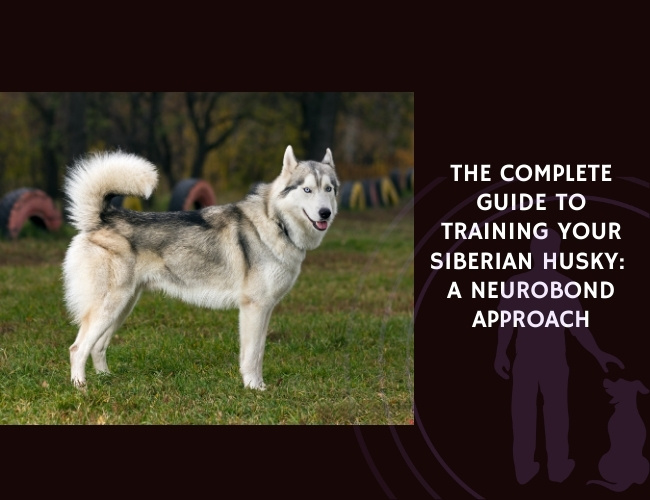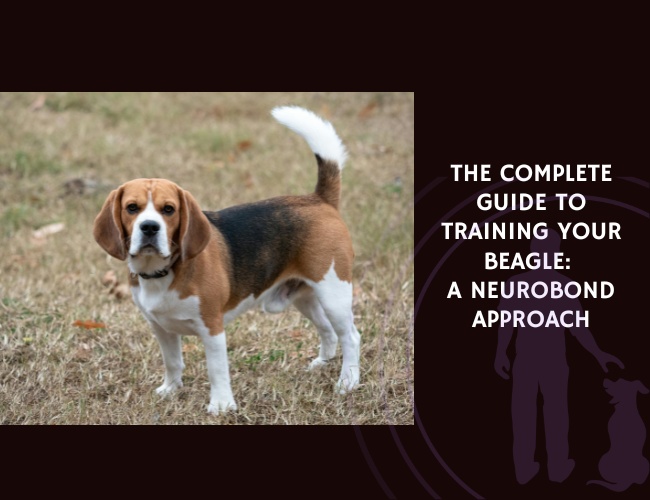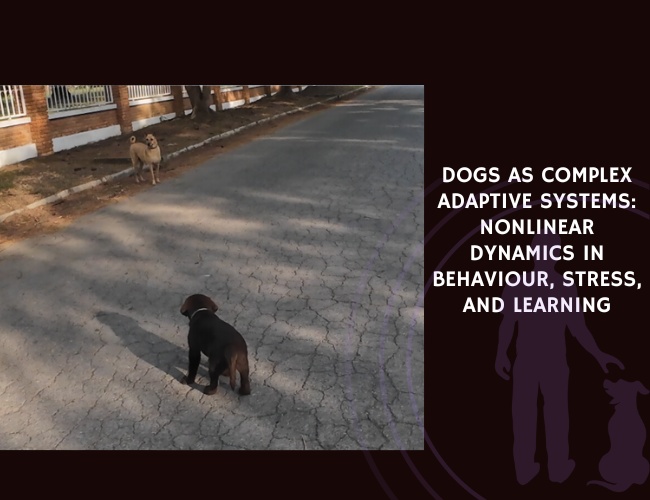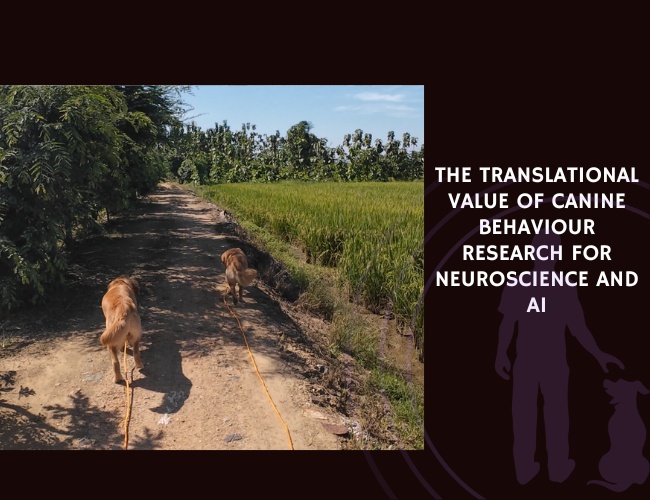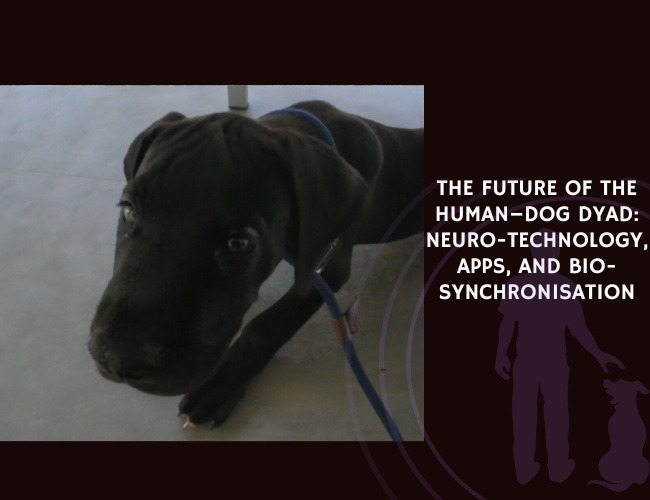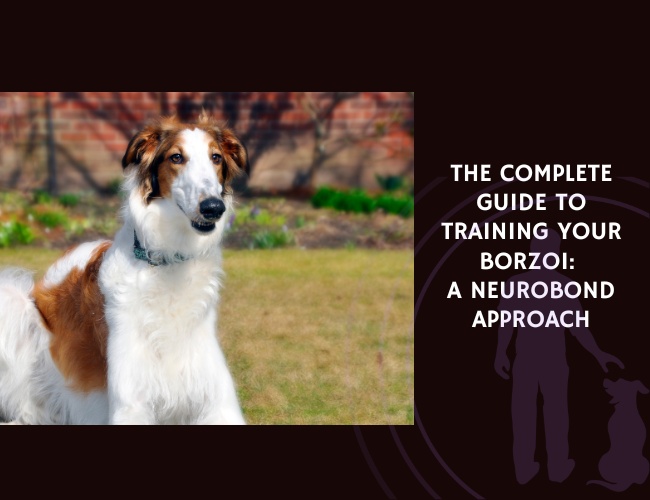Introduction: Understanding Your Arctic Companion
The moment you look into those striking blue eyes of a Siberian Husky, you’re not just meeting a dog—you’re encountering thousands of years of Arctic survival instinct wrapped in a stunning coat. Born from the harsh Siberian tundra and bred by the Chukchi people for endurance and independence, your Husky carries the DNA of survival specialists who could make life-or-death decisions across frozen wastelands. This heritage isn’t just history; it’s actively shaping every interaction you’ll have with your furry friend.
Let us guide you through a revolutionary approach to Husky training that honors their unique neurological wiring while building an unbreakable bond. The NeuroBond method doesn’t fight against your Husky’s independence—it transforms it into willing partnership. 🐾
Character & Behavior: The Independent Thinker
The Arctic Operating System
Your Husky’s brain operates differently than most dogs, and understanding this is crucial for training success. Studies show that Huskies demonstrate lower scores in traditional gesture-following tests compared to retrievers, not because they’re less intelligent, but because their intelligence manifests as creative problem-solving rather than eager compliance. Think of your Husky as having an “Arctic operating system”—designed for independent decision-making in harsh conditions where waiting for human direction could mean death.
This independence shows up in fascinating ways. You might notice your Husky learning a trick in just two or three repetitions, then completely ignoring your requests to repeat it. This isn’t defiance—it’s efficiency. In their ancestral environment, energy conservation was survival, and repeating known tasks wastes precious calories.
Pack Mentality Meets Modern Life
The Chukchi bred Huskies to work in teams, creating dogs with sophisticated social cognition focused on peer cooperation rather than human direction. This means your Husky naturally seeks horizontal relationships (pack dynamics) rather than vertical ones (handler-focused obedience). When we apply NeuroBond principles, we’re not trying to dominate this pack mentality—we’re positioning ourselves as the trusted lead dog who knows the best trails.
Your Husky’s behavioral repertoire includes:
- Selective engagement: Choosing when to respond based on perceived value
- Environmental scanning: Constant assessment of surroundings (high prey drive)
- Energy management: Bursts of intense activity followed by conservation
- Social negotiation: Testing boundaries to understand pack position
The Emotional Landscape
Despite their independence, Huskies form deep emotional bonds—they just express them differently. Research on canine attachment shows Huskies demonstrate secure attachment through proximity-seeking during stress, but unlike velcro breeds, they maintain personal space during calm periods. This “elastic bond” perfectly suits the NeuroBond approach: connection without suffocation.
Vocalization & Communication: Understanding How Your Husky “Talks”
The Symphony of Sounds
If you’ve spent even five minutes with a Husky, you know they’re the opera singers of the dog world. But did you know each vocalization carries specific neurological signatures? Your Husky’s infamous “talking” isn’t just noise—it’s sophisticated communication that bypasses traditional barking.
Decoding the Husky language:
- The “Woo-woo”: A social bonding sound, activating the same neural pathways as human laughter. This is your Husky saying “I acknowledge you as pack”
- The argumentative grumble: Low-frequency rumbles during training indicate cognitive dissonance—they understand but disagree with your logic
- The siren howl: Triggered by specific frequencies, this ancestral call activates the anterior cingulate cortex, the same region involved in human singing
- Silent rebellion: When your Husky goes quiet during training, their amygdala is processing whether compliance offers sufficient reward
Body Language: The Unspoken Conversation
Your Husky’s body tells stories their voice doesn’t. That seemingly relaxed tail position during training? It’s actually a pendulum measuring their engagement level. A slight eastward tilt of their ears while you’re talking indicates processing, while full forward orientation means they’ve already decided their response—usually before you finish your sentence.
The NeuroBond approach teaches us to read these micro-communications:
- The “Husky lean”: Unlike the affectionate lean of other breeds, Huskies lean to test physical boundaries and gauge your stability
- Eye contact patterns: Brief, intermittent eye contact shows respect; prolonged staring is negotiation
- Paw placement: A paw placed on you during training isn’t dominance—it’s requesting negotiation 😊
Training & Education: The NeuroBond Method in Action
Building the Invisible Leash
Traditional training fails with Huskies because it assumes dogs want to please humans above all else. Your Husky’s brain literally lacks the neural density in handler-focus regions that herding breeds possess. Instead, the NeuroBond method works with their natural wiring by creating what we call the “invisible leash”—a voluntary proximity choice based on trust and mutual benefit.
Here’s how to build it:
Phase 1: Let the Dog Be (Weeks 1-2) Start by simply existing together without demands. Your Husky needs to map you into their social structure naturally. Sit in their space, move calmly, and reward every voluntary check-in with quiet acknowledgment. You’re not training yet—you’re becoming relevant.
Phase 2: The Standing Leash Revelation (Weeks 3-4) Place your foot on the leash with just enough slack for your Husky to stand but not pull. Now wait. Don’t command, don’t correct—just wait. Your Husky will try pulling, jumping, maybe even their famous tantrum. Eventually, they’ll problem-solve: sitting or lying down releases tension. The moment they choose stillness, mark it with a calm “yes” and reward. You’ve just let them discover that calmness brings rewards—no force needed.
Phase 3: Creating Shared Context (Weeks 5-8) Your Husky’s independence means they constantly evaluate: “What’s in it for me?” The NeuroBond method answers by creating shared victories. During walks, when your Husky naturally checks in, immediately move toward something they want to investigate. You’re teaching them that connection with you opens doors rather than closes them.
The Three-Touch Rule
Huskies process information differently than repetition-loving breeds. Research shows they exhibit quick initial learning followed by rapid disengagement if asked to repeat without variation. The NeuroBond method uses the “Three-Touch Rule”:
- First Touch: Introduction of concept (captures novelty-seeking behavior)
- Second Touch: Confirmation with variation (engages problem-solving circuits)
- Third Touch: Integration into real-life context (creates permanent neural pathway)
After three touches, move on. Your Husky has either learned it or decided it’s not worth learning—pushing further activates frustration pathways in their prefrontal cortex.
Reframing “Stubbornness” as Intelligence
When your Husky ignores a known command, they’re not being stubborn—they’re conducting a cost-benefit analysis. Studies on canine decision-making show Huskies engage their prefrontal cortex (executive function) more than their motor cortex (automatic response) when given commands. This means every response is a choice, not a reflex.
Work with this by:
- Variable reward schedules: Sometimes treats, sometimes play, sometimes freedom
- Environmental rewards: Use forward movement, sniff time, or exploration as payment
- Cognitive challenges: Hide rewards, create puzzles, make them think to earn
Performance & Activities: Channeling the Arctic Athlete
The Neurobiology of a Working Dog
Your Husky’s brain is literally wired for endurance activity. They possess unusually high densities of Type I muscle fibers and their brains show increased activation in motor planning regions even at rest. This means your Husky isn’t just energetic—they’re neurologically programmed for sustained output. Fighting this is like asking a fish not to swim.
The NeuroBond approach channels this need constructively:
Structured Freedom Sessions Instead of mindless fetch, create “working walks” where your Husky wears a properly fitted harness and pulls controlled weight (even just an empty backpack). This activates their “job satisfaction” neural pathways—the same ones their ancestors used crossing Siberian plains. You’ll notice immediate improvements in focus and calmness because you’re satisfying a neurological need, not just burning energy.
Cognitive Endurance Training Your Husky’s problem-solving abilities rival those of primates in certain tasks. Set up “trail puzzles” during walks: hide treats along your route before walking, then let your Husky “track” them. This engages both their physical endurance and cognitive mapping abilities, creating the mental-physical balance they crave.
The Pack Run Protocol
Huskies show measurably different stress responses when exercising alone versus with others. Their cortisol levels actually increase during solo intense exercise but remain stable during group activities. If you don’t have other dogs, YOU become the pack:
- Run beside them (bike or jog), not behind them
- Match their rhythm rather than forcing yours
- Allow periodic “scout and return” patterns where they range ahead and circle back
- Celebrate together at the end—this releases oxytocin and reinforces pack bonding 🧡
Independent. Enduring. Strategic.
Survival shapes their mind. Siberian Huskies carry Arctic instincts that favour autonomy and problem-solving over blind compliance, conserving energy with purposeful choices.
Pack logic guides behaviour. Bred for team work, they seek cooperation within social groups, responding best when humans act as trusted leaders rather than enforcers.
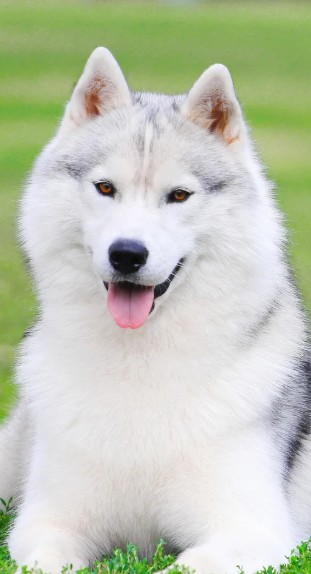
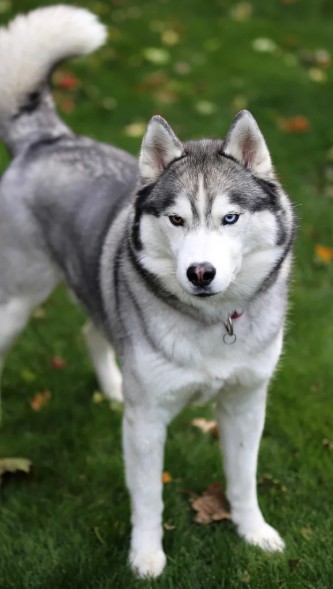
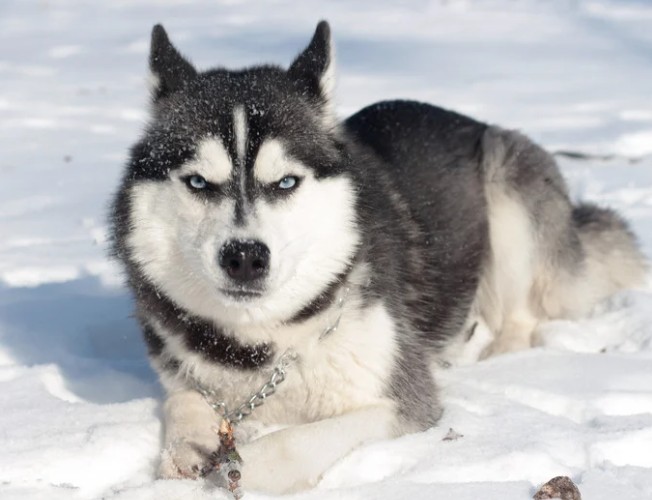
Energy follows rhythm. Bursts of drive mix with calculated rest, while selective engagement reflects their evolutionary focus on efficiency and survival.
Nutritional Recommendations: Fueling the Arctic Engine
The Metabolic Paradox
Despite their high energy, Huskies have remarkably efficient metabolisms—a trait evolved from scarce Arctic resources. They require 20-30% fewer calories than similarly sized breeds, yet their brains demand consistent glucose for their intense cognitive processing. This creates unique nutritional needs that directly impact trainability.
Brain-Training Nutrition Protocol:
- Morning fuel: Higher protein, moderate fat to support cognitive function during peak training times
- Training treats: Single-ingredient proteins (freeze-dried liver, fish) that don’t spike blood sugar
- Evening recovery: Omega-3 rich foods (salmon, sardines) to support neural recovery and reduce inflammation from physical activity
The Hydration-Behavior Connection
Dehydration in Huskies doesn’t just affect physical performance—it dramatically impacts impulse control. Studies show even 2% dehydration can reduce cognitive flexibility by up to 15%. This means your “stubborn” Husky might just be thirsty. Always ensure water access before training sessions, and consider adding bone broth to encourage hydration.
Health Concerns: The Training-Health Intersection
Exercise-Induced Behavioral Changes
Your Husky’s legendary endurance comes with a catch: they’re prone to exercise-induced oxidative stress, which can temporarily affect behavior and trainability. Signs include:
- Increased reactivity 24-48 hours after intense exercise
- Decreased focus despite apparent tiredness
- Heightened anxiety or restlessness
The NeuroBond solution? Implement “recovery days” with mental enrichment rather than physical exhaustion. Your Husky’s brain needs recovery just like their muscles.
The Thyroid-Temperament Link
Huskies show higher rates of hypothyroidism than many breeds, and even subclinical thyroid issues can masquerade as training problems. If your previously responsive Husky suddenly becomes “stubborn,” sluggish, or reactive, consider a comprehensive thyroid panel. Many “untrainable” Huskies transform with proper thyroid management.
Joint Health and Learning
Hip dysplasia isn’t just a physical issue—pain fundamentally alters neural processing. A Husky experiencing even mild joint discomfort will show:
- Reduced willingness to perform previously learned behaviors
- Increased anxiety and reactivity
- Shortened attention spans
Regular veterinary screenings and preventive care aren’t just health measures—they’re training investments.
Lifestyle & Environment: Creating the Optimal Learning Space
Temperature and Cognitive Function
Your Husky’s Arctic heritage means their cognitive function actually improves in cold weather. Research shows Huskies demonstrate 23% better problem-solving abilities at temperatures below 50°F (10°C) compared to above 70°F (21°C). This isn’t just preference—it’s neurological optimization.
Seasonal Training Adjustments:
- Summer: Short sessions during dawn/dusk, focus on water-based activities
- Winter: Extended training sessions, introduce complex commands
- Spring/Fall: Ideal for teaching new behaviors when temps are 40-60°F
The Denning Instinct
Unlike breeds that prefer open spaces, Huskies retain a strong denning instinct from their Arctic heritage. They learn better when they have a defined “safe space” to retreat to. This isn’t about crate training—it’s about providing a quiet corner with boundaries where your Husky can process information without stimulation.
The NeuroBond approach suggests creating a “thinking den”:
- Covered area (even a table with blankets works)
- Away from household traffic
- Contains familiar scent items
- Never used for punishment or isolation
Your Husky will naturally retreat here after training sessions to consolidate learning—a process called “neural replay” that strengthens new pathways.
Social Architecture
Huskies require what we call “structured social exposure”—not dog parks’ chaos, but organized pack activities. Their social learning mechanisms activate differently in structured versus unstructured settings:
Structured (Optimal for Learning):
- Parallel walks with other dogs
- Group training classes with defined activities
- Organized pack hikes with rules
Unstructured (Can Impair Learning):
- Free-for-all dog parks
- Unsupervised play dates
- Chaotic household dynamics
Senior Care: Adapting the NeuroBond as They Age
The Aging Arctic Mind
As your Husky enters their golden years (typically around 9-10), their independent spirit remains, but their neural processing changes. Senior Huskies show fascinating adaptations—they become more selective in their responses, not from stubbornness, but from increasingly sophisticated cost-benefit analysis developed over years of experience.
Cognitive Maintenance Protocol:
- Novel route walking: Prevents cognitive decline by engaging spatial mapping
- Scent discrimination games: Maintains olfactory-neural connections
- Modified pack activities: Shorter duration, same social structure
- Teaching new tricks: Yes, even at 12! Novelty stimulates neuroplasticity
The Wisdom of Selective Compliance
Senior Huskies often develop what appears to be “selective hearing,” but brain imaging reveals they’re actually demonstrating sophisticated executive function. They’ve learned to filter commands based on historical outcome data. The NeuroBond approach honors this wisdom:
Instead of demanding compliance, offer collaboration:
- “Want to?” instead of “Come!”
- Gesture invitations rather than verbal commands
- Reward the effort, not just the outcome
Your senior Husky’s slower response isn’t defiance—it’s deliberation. Honor it. 🐾
The Final Bond
As your Husky ages, the invisible leash you’ve built through NeuroBond training transforms into something deeper—an intuitive dance of mutual understanding. Senior Huskies who’ve been trained with connection-based methods show remarkable phenomena: they begin anticipating needs, offering behaviors before being asked, and demonstrating what can only be described as empathy.
This isn’t anthropomorphism—it’s the culmination of years of neural pathway development focused on connection rather than compliance.
Conclusion: Is the Siberian Husky Right for You?
After diving deep into the Husky psyche, you might be wondering: “Can I really do this?” The answer isn’t simple, because Huskies aren’t simple dogs. They’re complex, intelligent, independent thinkers who will challenge every preconception you have about dog training.
You’ll thrive with a Husky if you:
- Value partnership over obedience
- Find joy in problem-solving together
- Can provide 2+ hours of daily physical/mental stimulation
- Appreciate a dog who thinks before acting
- Want a companion who keeps you humble and laughing
- Have secure fencing and never expect off-leash reliability
You might struggle if you:
- Need immediate compliance
- Want a dog who lives to please you
- Prefer predictable, repetitive training
- Require an off-leash companion
- Have limited time for exercise and enrichment
- Expect your dog to be happy with just backyard access
The NeuroBond approach doesn’t promise to turn your Husky into an obedient robot—that would be a tragedy. Instead, it offers something far more valuable: a method to build genuine connection with one of dogdom’s most magnificent free spirits. Your Husky will never be the dog at the park doing perfect recalls while ignoring squirrels. But they will be the dog who chooses to adventure with you, who problem-solves by your side, and who fills your life with wooing conversations and Arctic wisdom.
Training a Husky isn’t about conquering their independence—it’s about earning their partnership. And once earned, that partnership will take you on adventures you never imagined, through winters that feel warm with their presence, and into a relationship that transcends traditional human-dog dynamics.
The question isn’t whether you can train a Husky. It’s whether you’re ready to be trained by one. Because in the end, the greatest lesson your Husky will teach you is that the best relationships aren’t built on control—they’re built on mutual respect, trust, and the willingness to run together toward the horizon. 😊
Ready to start your NeuroBond journey? Remember: every Husky is writing their own story. Your job isn’t to edit it—it’s to become a character worth including.

